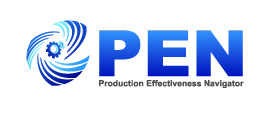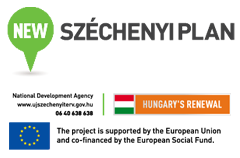The task of PEN (Productivity Effectiveness Navigator), a decision supporting software (EUROSTARS E!-6232) is to create scenarios that are capable to efficiently manage situations and minimise damage in case of events related to the production (failure of equipment involving overhaul, shortfall of a supplier, logistical problems caused by natural catastrophes etc).
PEN Production Effectiveness Navigator
Methods for mid-term planning of production program and resources has been developed and embedded with a reference model. A prototype is implemented including data interfaces that are made public. The prototype is evaluated on real-world samples.
In order to provide the agility demanded by the markets, enterprises need to react quickly on market demands, keep flexibility towards changes in their environment(e.g. changes in political and economic situation, changes in currency etc.), and find a risk and cost optimal development strategy for their resources. This can be achieved by the tools which can work on the data (e.g. stock info, supplier info, capacity info etc.) taken from enterprises using project result and from environment, and which can enable “Sandbox” experiments to study the challenges from possible future scenarios. There has not been any product in the markets that provide the functionalities mentioned on a suitable level of detail, nor the required mathematical methods and models could be found completely on the market.
Members of the Consortium
- HISBIM BILGI VE ILETISIM TEKNOLOJILERI SANAYI TICARET ANONIM SIRKETI, Turkey (coordinator)
- Next System Ltd., Hungary
- Infota Research Institute of Foundation for Information Society, Hungary
- IT Vision S.P. zoo., Poland
- Institute of Mathematics and Informatics, Lithuanian Academy of Sciences, Lithuania
- Baltic-Amadeus Joint Stock Company, Lithuania
The PEN project’s goal was to provide efficient methods to the manufacturing enterprises (such as metal industry, automotive industry, textile industry) in order to combine their mid-term plans according to the production resources. By the end of the project, our goal was to have a software prototype which implemented these methods via datawarehousing and interfacing technologies essential for this purpose and to be compatible with ERP products (e.g. SAP, Microsoft Nav etc.).
The supported functionalities have included “what if” – evaluations on the production programme (e.g. to judge about the portfolio, but also to react on very specific customer requests) and scenario techniques to analyze potential impact from the environment in a “sandbox”, in order to be able to react in an agile way on developments that cannot be influenced by the enterprise.
In the technical applications side:
- One of the works was setting up the reference model, the demands of users related to the planning processes and the basic data relations.
- The Integrated Enterprise Modelling (IEM) method has been applied. The use of IEM will be continued, as far as process interactions are concerned. The approach of Gutzwiller has been used for the description of the methods developed in the project. The research methods forming the basis for the methods, which are used in the project, have finally been defined as a result from the first step. Agent-based simulation, cluster analysis, discriminant analysis, non-linear regression, time series analysis, neuro fuzzy methods and support vector machines were the foreseen candidates for the selection.
- UML has been used for developing “operational model definer”. The development procedure follows the V-Model XT. Especially, for the software development HISBIM used CMMI.
- Methods of structured programming have been applied for developing the level of the database and interface. Testing has followed the validation procedures defined by ISO/IEC_15408.
In the market applications side:
- One of the main goals of this project was establishing a new level of business planning for the ERP based management methods.
- Methods using complex simulation technology are demonstrated as a new element of the corporate management culture during making business critical decisions
The Consortium has consisted of 5 members whose tasks were the following:
- HISBIM was the coordinator of the project. HISBIM is a company which develops sector based software, making consultancy and training about manufacturing planning ERP.
- ITA was responsible for the simulation part of the project. The backbone of the ITA staff is made up of persons with scientific degrees, many-decade practice in scientific research and academic education, as well as of experts with significant business and public administration expertise, furthermore middle and senior managerial practice.
- Next Ltd.’ s expertise is software development and support on Microsoft based PC environment, research of software models for special service industry processes.
- IT Vision has provided expertise knowledge and experience in areas of designing solutions (i.e. software) for the business in the project. IT Vision is the system integrator and software developer that provides services for SMEs.
- IMI has provided the reference model and the description of its application. This reference model includes the events and linked views on the core processes needed by the partners and an analysis of parameters that define a view and IMI has provided heuristic and deterministic algorithms related to specified event-driven views.
- BA was responsible for programming, technical implementation and experience in evaluation and designing of business oriented issues in the PEN project.
Innovative elements of the project
The project output can be used as a module for all ERP systems. There is not such a module which can be used under all ERPs.
In most of the current ERP systems, there is no planning via Artificial Intelligence (AI). However ERP systems, which have planning via AI, do not have an integrated simulation tool which can work in a bidirectional way which means that either the changes in the simulation tool affect the AI part, or the changes in the AI part affect the simulation tool. Current ERP Systems are making one year term plans, the output of the PEN project provides longer term plans (e.g. 3 years).
While a modern DSS cannot handle more than some tens of parameters and attributes of a decision situation because its methodological boundaries in complexity, inclusion of robust simulation and AI technologies into the decision supporting framework means that decision makers will be able to check hundreds of longer term scenarios having hundreds of parameters. This opens a new dimension in business strategy planning for a broad scale of organizations.
Project time frame
PEN project was realized in 7 work packages between 01. May 2011 – 31. October 2014.
Related materials
Processing of Undesirable Business Events in Advanced Production Planning Systems
Advanced Planning and Scheduling Systems – Modeling and Implementation Challenges
Heuristic Reactive Rescheduling Algorithms in the Advanced Scheduling Add-on for ERP
PEN project meeting photo gallery
https://www.eurostars-eureka.eu/project//id/6232
Publications:
- Caplinskas, G. Dzemyda, F. Kiss, A. Lupeikiené: Processing of Undesirable Business Events in Advanced Production Planning Systems. In: Informatica, Vol. 23, Iss. 4, pp. 563-580. Vilnius University, Lithuanian Academy of Sciences, 2012. ISSN: 0868-4952
- Audrone LUPEIKIENE, Gintautas DZEMYDA, Ferenc KISS, Albertas CAPLINSKAS: Advanced Planning and Scheduling Systems: Modeling and Implementation Challenges. In: Informatica, Vol. 25, Iss. 4, pp. 581-616. Vilnius University, Lithuanian Academy of Sciences, 2014. ISSN: 0868-4952
- Vytautas TIEŠIS, Gintautas DZEMYDA, Taskin KIZIL: Heuristic Reactive Rescheduling Algorithms in the Advanced Scheduling Add-on for ERP. In: Baltic J. Modern Computing, Vol. 2 (2014), No. 4, 272-284



